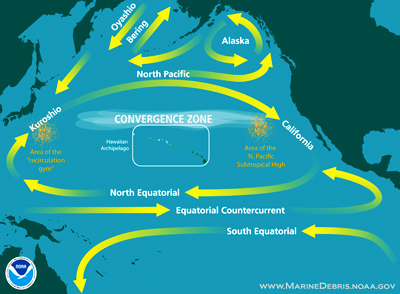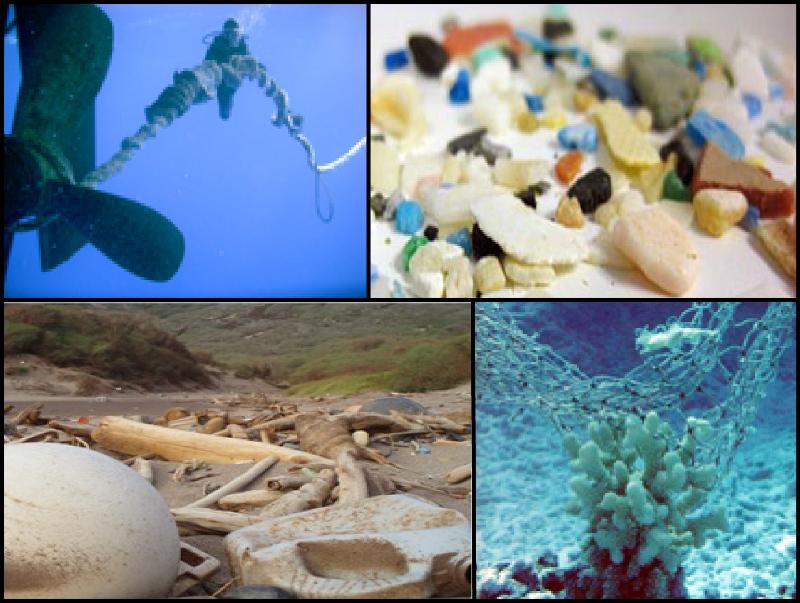|
The "garbage patch" is an area of marine debris concentrated in the North Pacific Ocean. But the name "garbage patch" is misleading. It can't easily be seen on satellite or aerial photographs. Instead, much of the accumulated debris is made up of microplastics (typically smaller than 5mm, or the length of a grain of rice). Floating debris, whether natural or man-made, accumulates due to the movement of ocean currents. No one has been able to accurately measure the full size of these accumulation regions. They are far offshore, difficult to access, and their boundaries may shift in time due to changing ocean conditions.
 | |
Simplified representation of major ocean currents and debris patches in the Pacific Ocean. Source: NOAA Marine Debris Program
|
Where does the debris come from? Marine debris can be dumped, blown off, or swept from fishing vessels, stationary platforms, cargo ships and other vessels. It can also come from land in the form of litter, garbage dumped in rivers and streams, industrial waste, stormwater discharge, and extreme natural disasters, like the recent Japanese tsunami or Hurricane Irene.
But aren't some plastics biodegradable? In general, "yes", but there are many things to consider. There are many different types of plastic (think of separating #5 and #2 types in your home recycling bin). Degradation rates depend on chemical composition, particle size, additives, water temperature, light environment, and other environmental conditions. Most commonly-used plastics never fully "go away" but instead break down into smaller and smaller pieces, or microplastics. And even truly biodegradable, bio-based plastics must typically be broken down in special industrial compost systems under conditions not found in the ocean.
Does marine debris hurt ocean animals? Yes! Among other impacts, debris can entangle marine organisms, especially in large debris such as derelict fishing gear. Animals, from zooplankton to fish, sea turtles and seabirds, can also ingest plastics which can choke them, cause intestinal blockage or poison them with organic toxins such as PCBs, PBDEs, and PAHs. These chemicals can even be passed through the food chain to harm other organisms indirectly.
 | |
Marine Debris: Navigation hazard, microplastics, derelict fishing gear, entanglement hazard. Source: NOAA Marine Debris Program
|
Can the trash be cleaned up? Because much of the plastic in our vast oceans is in very small fragments, there is no practical way to clean it up. Filtering water through nets may even do more harm than good, as this would remove a "by-catch" of microscopic plankton and other organisms that are important to the ocean ecosystem. Marine debris is a global problem being tackled by organizations at all levels through scientific research and educational programs. In fact, OGL's friends and collaborators at the Sea Education Association maintain a long-term monitoring and research program on marine debris and published a recent paper in Science detailing their research spanning two decades. The NOAA Marine Debris Program has supported more than 140 projects to address the problem across the U.S.
This is how you can help, no matter where you live:
- REDUCE the amount of trash you produce
- Choose items you can REUSE over disposable products
- RECYCLE items if you must dispose of them
|